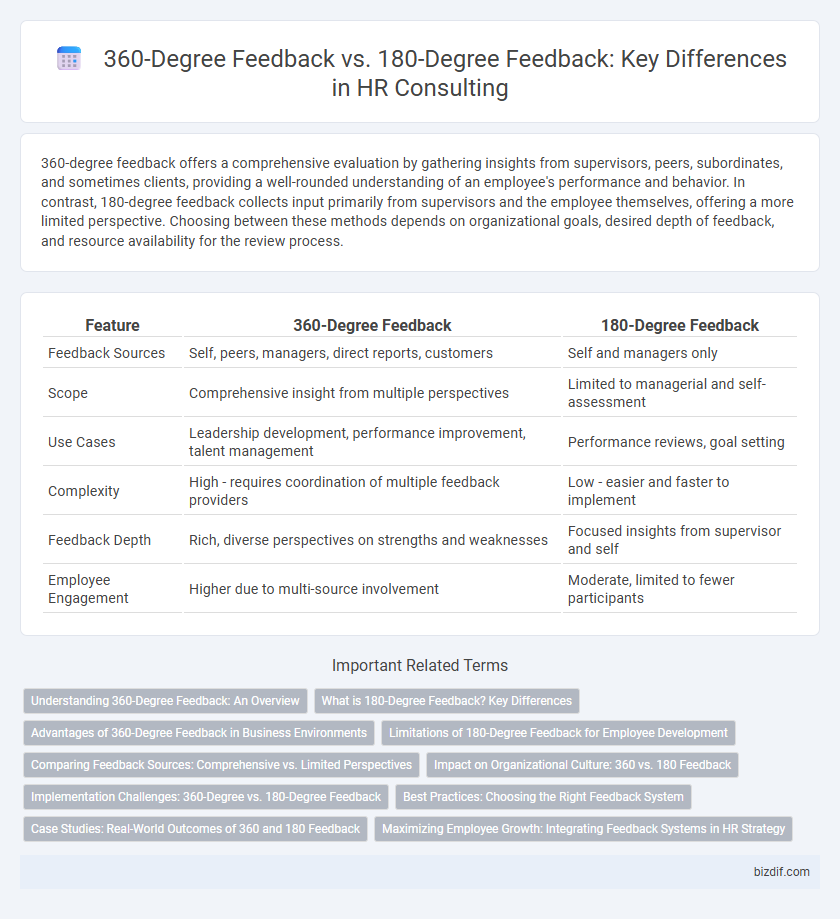360-degree feedback offers a comprehensive evaluation by gathering insights from supervisors, peers, subordinates, and sometimes clients, providing a well-rounded understanding of an employee's performance and behavior. In contrast, 180-degree feedback collects input primarily from supervisors and the employee themselves, offering a more limited perspective. Choosing between these methods depends on organizational goals, desired depth of feedback, and resource availability for the review process.
Table of Comparison
| Feature | 360-Degree Feedback | 180-Degree Feedback |
|---|---|---|
| Feedback Sources | Self, peers, managers, direct reports, customers | Self and managers only |
| Scope | Comprehensive insight from multiple perspectives | Limited to managerial and self-assessment |
| Use Cases | Leadership development, performance improvement, talent management | Performance reviews, goal setting |
| Complexity | High - requires coordination of multiple feedback providers | Low - easier and faster to implement |
| Feedback Depth | Rich, diverse perspectives on strengths and weaknesses | Focused insights from supervisor and self |
| Employee Engagement | Higher due to multi-source involvement | Moderate, limited to fewer participants |
Understanding 360-Degree Feedback: An Overview
360-degree feedback involves collecting performance evaluations from an employee's supervisors, peers, subordinates, and sometimes clients, offering a comprehensive view of strengths and areas for development. This multi-rater approach enhances self-awareness and supports targeted professional growth by capturing diverse perspectives within organizational hierarchies. Compared to 180-degree feedback, which typically includes only manager and self-assessments, 360-degree feedback provides a broader, more balanced evaluation essential for effective HR consulting strategies.
What is 180-Degree Feedback? Key Differences
180-degree feedback involves evaluations from an employee's manager and peers, excluding self-assessment and direct reports, providing a focused perspective on performance and behavior. Unlike 360-degree feedback, which gathers input from multiple sources including subordinates and sometimes customers, 180-degree feedback offers a streamlined, less complex review process. This narrower scope facilitates quicker implementation and targeted developmental insights, often used for mid-level employees or specific performance areas.
Advantages of 360-Degree Feedback in Business Environments
360-degree feedback provides a comprehensive evaluation by gathering insights from peers, subordinates, supervisors, and self-assessment, enhancing the accuracy of performance reviews. This holistic approach fosters employee development, increases self-awareness, and strengthens leadership skills, contributing to improved organizational culture and productivity. Businesses leveraging 360-degree feedback benefit from more balanced perspectives, leading to better talent management and targeted employee growth strategies.
Limitations of 180-Degree Feedback for Employee Development
180-degree feedback limits employee development by relying solely on self-assessment and manager evaluations, missing insights from peers and subordinates. This narrow perspective can lead to biased or incomplete performance evaluations, hindering comprehensive growth opportunities. Without diverse viewpoints, employees may lack awareness of key behavioral blind spots critical for skill enhancement and effective leadership development.
Comparing Feedback Sources: Comprehensive vs. Limited Perspectives
360-degree feedback gathers insights from multiple sources, including peers, subordinates, supervisors, and self-assessment, offering a comprehensive view of employee performance and behaviors. In contrast, 180-degree feedback relies primarily on evaluations from supervisors and self-assessment, providing a more limited perspective. The broader input in 360-degree feedback enhances development opportunities by capturing diverse viewpoints, while 180-degree feedback simplifies the process with focused feedback from fewer sources.
Impact on Organizational Culture: 360 vs. 180 Feedback
360-degree feedback fosters a culture of transparency and continuous improvement by incorporating insights from peers, subordinates, and supervisors, leading to greater employee engagement and trust. In contrast, 180-degree feedback, limited to manager and self-assessment, may reinforce top-down communication and hinder open dialogue within teams. Organizations implementing 360-degree feedback often experience enhanced collaboration and alignment with core values, driving a more inclusive and adaptive culture.
Implementation Challenges: 360-Degree vs. 180-Degree Feedback
Implementing 360-degree feedback presents challenges such as managing extensive data from multiple sources, ensuring anonymity, and addressing potential biases from a broader audience. In contrast, 180-degree feedback typically involves fewer stakeholders, facilitating quicker collection and simpler data interpretation but may limit comprehensive insights into employee performance. Effective HR consulting must balance these factors, tailoring the feedback process to organizational culture and capacity for managing complexity.
Best Practices: Choosing the Right Feedback System
Best practices for choosing the right feedback system emphasize aligning 360-degree and 180-degree feedback methods with organizational goals and culture. 360-degree feedback collects comprehensive insights from peers, subordinates, and supervisors, enhancing leadership development and team dynamics, while 180-degree feedback targets manager-to-employee evaluations, suitable for focused performance appraisals. Selecting the appropriate system involves assessing the purpose, feedback scope, and participant readiness to maximize effectiveness and employee engagement.
Case Studies: Real-World Outcomes of 360 and 180 Feedback
Case studies reveal that 360-degree feedback fosters comprehensive performance improvement by incorporating insights from peers, subordinates, and supervisors, enhancing leadership development and organizational communication. In contrast, 180-degree feedback primarily captures managerial perspectives, proving effective for straightforward performance appraisals but less impactful for behavioral change and team dynamics. Organizations leveraging detailed 360-feedback often report increased employee engagement and targeted skill enhancement compared to those using 180-degree feedback alone.
Maximizing Employee Growth: Integrating Feedback Systems in HR Strategy
Maximizing employee growth requires integrating 360-degree feedback systems to provide comprehensive evaluations from supervisors, peers, and subordinates, enabling nuanced performance insights. In contrast, 180-degree feedback limits input primarily to supervisors and self-assessment, restricting the scope of developmental data. Incorporating 360-degree feedback within HR strategy fosters enhanced self-awareness, targeted skill development, and aligns employee growth with organizational objectives.
360-degree feedback vs 180-degree feedback Infographic

 bizdif.com
bizdif.com